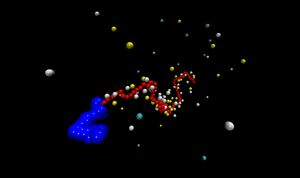DNA Electrophoresis
Electrophoresis is one of the main techniques to separate DNA molecules by size and has shown its effectiveness in the sequencing of entire genomes, including our own. This success story also increased the demand for improved and faster sequencing methods, in order to meet the upcoming challenges.
More recently, the DNA has been investigated as a material for the self assembly of complex three dimensional structures. These structures have been investigated in the scientific community as a material for drug delivery or nanomachines. However, even the fundamental understanding of the ion dynamics in electric field driven nanopore translocation of such structures is not fully understood yet. Such systems are therefore investigated via a multi-scale approach from all-atom models to mean-field models.
Special topics that are currently under investigation are:
- free-solution electrophoresis
- end-labeled free-solution electrophoresis
- electrophoresis in confined geometries
- current modulation of DNA structures in a pore
Hydrodynamic interactions are implemented in simulations by using a frictional coupling of the MD particles to a Lattice Boltzmann fluid. This efficient way of treating hydrodynamics enables a detailed study of the complex electrohydrodynamic interactions.
Coworkers
- Christian Holm: Project supervisor
- Kai Szuttor
- Kai Grass: PhD thesis on Hydrodynamic effects in polyelectrolyte electrophoresis
Collaborators
- M. Hervé Cottet, CNRS laboratory, Université Montpellier 2, Montpellier, France
- Ulrich Scheler, Leibnitz-Institute for Polymer Research (IPF), Dresden, Germany
- Gary W. Slater, University of Ottawa, Ottawa, Canada
Publications
-
Kai Szuttor, Florian Weik, Jean-Noël Grad, Christian Holm.
Modeling the current modulation of bundled DNA structures in nanopores.
The Journal of Chemical Physics 154(5):054901, 2021.
[PDF] (3.0 MB) [Preprint] [DOI]
-
Patrick Ahlrichs, Burkhard Dünweg.
Simulation of a single polymer chain in solution by combining lattice Boltzmann and molecular dynamics.
The Journal of Chemical Physics 111(17):8225–8239, 1999.
[PDF] (211 KB) [DOI]
Links
 Poster presented at MMSD07 (159 KB)
Poster presented at MMSD07 (159 KB)
